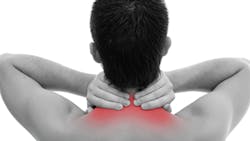Text Neck: The Link Between Texting and Musculoskeletal Injuries
If you spend long periods of time texting each day, your favorite method of communication might end up creating a literal pain in the neck. Doctors even have a term for this ailment caused by too tilting your head forward and down while tapping out text messages: text neck.
“People get so focused on these devices that they end up holding their neck and upper back in abnormal positions for a long period of time; enough that other people coined the phrase ‘text neck,’ which is essentially referring to postural pain,” said Chris Cornett, M.D., orthopaedic surgeon and spine specialist at the University of Nebraska Medical Center Department of Orthopaedic Surgery and Rehabilitation.
“Text neck” is defined as overuse syndrome involving the head, neck and shoulders. It typically results from excessive strain on the spine from looking in a downward position at hand held devices such as cell phones, mp3 players, e-readers and computer tablets. This behavior might even cause long-term increased stress on the other structures in your neck, such as the discs and joints.
Cornett suggests three ways to help alleviate or avoid text neck becoming a pain in your neck:
1. Modify the position of the device. Instead of having the cell phone or other device in your lap, which compels you to lean your head down, find a way to hold the device at a neutral, eye level.
2. Take breaks. Be aware that you’re using these technology devices throughout the day and force yourself to take a break and to change or alter your position.
3. Become physically fit. Having a strong, flexible back and neck will help you deal with abnormal stresses and reduce musculoskeletal issues.
“When you hold your body in an abnormal position, it can increase stress on the muscles, cause fatigue, muscle spasms and even stress headaches,” Cornett said. “With every degree of motion to the front or side that you move your head, the stress on your neck is magnified beyond just the weight of the head.”
Related: Protecting Your Back, Neck and Arms from "Laptop-itis"
About the Author

Laura Walter
Laura Walter was formerly senior editor of EHS Today. She is a subject matter expert in EHS compliance and government issues and has covered a variety of topics relating to occupational safety and health. Her writing has earned awards from the American Society of Business Publication Editors (ASBPE), the Trade Association Business Publications International (TABPI) and APEX Awards for Publication Excellence. Her debut novel, Body of Stars (Dutton) was published in 2021.
